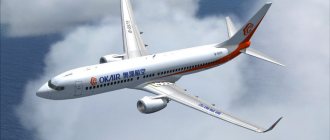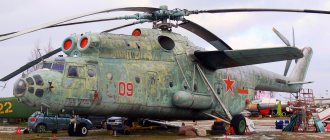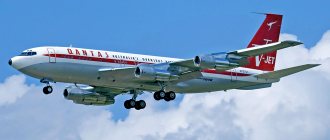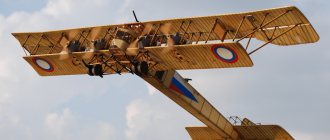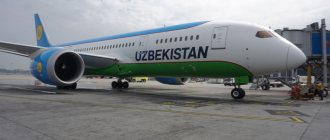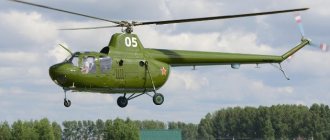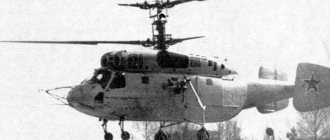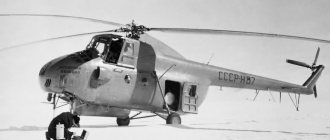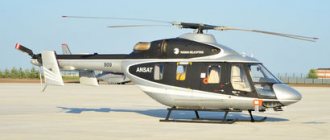| RAH-66 Comanche | |
| RAH-66 Comanche prototype in flight | |
| Type | reconnaissance and attack helicopter |
| Developer | Boeing/Sikorsky |
| First flight | January 4, 1996 |
| Status | program closed 02/24/2004 |
| Main operators | US Army |
| Units produced | 2 |
| Images on Wikimedia Commons | |
Boeing / Sikorsky RAH-66 ComancheBoeing / Sikorsky RAH-66 Comanche
Boeing / Sikorsky RAH-66 Comanche
(eng.
Boeing / Sikorsky RAH-66 Comanche
) is an American project of a multi-role reconnaissance and attack helicopter.
Development history
In 1991, the joint team of Boeing and Sikorsky, which presented the RAH-66 reconnaissance and combat helicopter project, was recognized as the winner of the LHX (Light Helicopter Experimental) competition. LHX helicopters were intended to replace Bell AH-1 combat helicopters, Bell UH-1 multi-purpose helicopters and reconnaissance helicopters. Bell OH-58 and Hughes OH-6 helicopters. It was planned to build 4000-6000 helicopters in reconnaissance (LHX-SCAT) and multi-purpose (LHX-UTIL) versions in 1990-1994. The total cost of helicopter development was estimated at $2.8 billion, and the production cost was $24–36 billion, making the LHX program the largest of all helicopter programs.
The first flight of the experimental RAH-66 “Comanche” helicopter took place on January 4, 1996, flight tests of the second experimental helicopter were planned to begin in 1998, and flight tests were planned for 2001 to evaluate the tactical capabilities of helicopters intended for military testing. In total, it was planned to build six helicopters for such tests. The start of serial production was planned for 2006, it was assumed that 1292 helicopters would be delivered to the US Army with a total cost of more than $34 billion.
On February 23, 2004, the US Army decided to close the Comanche helicopter program. The experience of the wars in Iraq and Afghanistan has shown that it is much cheaper and more effective to use unmanned reconnaissance aircraft than to invest in the production of reconnaissance helicopters and training of pilots with the subsequent risk to vehicles and crews. More than $8 billion had already been invested in the program at that time, and in addition, Boeing-Sikorsky received $450–680 million as a reward for the US Army's abandonment of the program.
Technologies developed for the Comanche will be used to modernize McDonnell Douglas's AH-64 Apache helicopters and other US military helicopters.
Prototype 95-0001 "The DUKE" is currently housed at the US Army Aviation Museum at Fort Rucker, Alabama; prototype 94-0327 arrived at the museum in 2008.
Recommendations
Citation List of references used
- Eden, Pavel, ed. (2004). Encyclopedia of Modern Combat Aircraft
. London: Amber Books. ISBN 1-904687-84-9. - Brooks Frederick (2010). Design Design: Essays from a Computer Scientist
. Upper Saddle River, New Jersey: Addison Wesley. ISBN 0-201-36298-8. - Crawford, Steve (2003). Twenty-first century Military helicopters
. St. Louis, Minnesota: MBI Publishing. ISBN 0-7603-1504-3. - Frawley, Gerard (2002). International Directory of Military Aircraft
. Fyshwick, ACT: Aerospace Publications. ISBN 1-875671-55-2. - Harding, Stephen (1997). "Boeing-Sikorsky N-66 Comanche." US Army aircraft Since 1947
. Atglen, PA: Schiffer Publishing. ISBN 0-7643-0190-X. - Williams, Cindy (2001). Holding the Line: A US Defense Alternative for the Early 21st Century
. Cambridge, MA: MIT Press. ISBN 978-0-262-73140-9. - Wilson, Stuart (2000). Combat aircraft since 1945
. Fyshwick, ACT: Aerospace Publications. ISBN 1-875671-50-1.
Design
The cockpit is designed according to the “tandem” design. The tail rotor of the helicopter is made according to the fenestron design. A fundamentally new feature of the helicopter is the presence of two side compartments for the intra-fuselage placement of missiles. The design also includes removable side pylons for additional fuel tanks and weapons.
During the design, attention was paid to the issues of combat survivability of the helicopter: ensuring the explosion and fire safety of the fuel system, armor protection of the crew, resistance to damage to the rotor blades. The developers of the RAH-66 managed to create a vehicle with good flight characteristics, high power density and low visibility.
Stealth
When designing a reconnaissance and attack helicopter, the main attention was paid to the overall reduction in the visibility of the vehicle in the radar (RL), infrared (IR), optical and acoustic parts of the spectrum. For this purpose, composite materials based on polymer binders (PCM) are widely used in the helicopter design. The front part of the fuselage is made of epoxy carbon fiber. In accordance with the rules of stealth technology, the outer surfaces of the fuselage are made in the form of flat edges for diffuse reflection of incident high-frequency radiation, critical (in terms of reflection level) surface areas are made of radio-absorbing materials, and special coatings are used. Also, to reduce visibility, the weapon suspension and the 20-mm XM301 cannon mount are retractable into the fuselage.
The ESR of the Comanche is 360 times less than that of the Apache helicopter in the PPS, 250 times less than that of the OH-58D Kiowa Warrior in the PPS and 32 times less than the OH-58D Kiowa Warrior in the ZPS (in the 10 GHz range). Also, the helicopter's EPR is smaller than that of the AGM-114 Hellfire missile.
The acoustic signature of the Comanche helicopter is significantly lower than other helicopters of the same class.
Comanche helicopter weapon
The RAH-66 Comanche is armed with a built-in XM301 automatic cannon (Vulcan-2) with a block of rotating barrels and a variable rate of fire. The gun is made with three barrels and has a caliber of 20 mm. The total ammunition capacity of the XM301 is normal - 320, maximum - 500 shells. The rate of fire against air targets is 1,500 rounds/min, against ground targets—750 rounds/min.
The gun is mounted on a special rotating turret at the bottom of the forward fuselage and can fire at targets in the forward hemisphere. If necessary, it can be retracted into the fairing and folded into a special casing. The gun has an unusual ammunition supply system; it is carried out using a special conveyor. This method of ammunition supply is used due to the small volumes of the helicopter’s bow. The gun's drum magazine with 500 rounds is located under the pilot-operator's cabin, at a considerable distance from the gun.
The helicopter can be equipped with missiles located in 2 on-board cargo compartments for weapons; they are located on both sides of the fuselage in its middle part. The holders located on the inside of the opening side hatches of the cargo compartments are used as suspension units. Each leaf has three suspension units and is raised to a horizontal position before using the weapon. The compartments can accommodate air-to-air guided missiles - Stinger AIM-92, laser-guided air-to-surface missiles - Hellfire AGM-114. Flares and 70mm unguided Hydra 70 rockets can be used.
The Comanche helicopter's missile armament can be expanded through the use of additional EFAMS hardpoints. They are installed on the sides of a helicopter and consist of two small wings. It is also possible to install such a suspension system in the field.
Performance characteristics
Data source:
Jane's [1]
Specifications
- Crew:
2 people (pilot and operator) - Length:
14.28 m - Fuselage length:
13.2 m (without cannon) - Main rotor diameter:
12.9 m - Fenestron diameter:
1.37 m - Maximum fuselage width:
2.04 m - Height:
3.37 m (to main rotor) - Rotor swept area:
116.74 m² - Empty weight:
4,218 kg - Normal take-off weight:
5,601 kg (with 4×Hellfire and 2×Stinger) - Maximum take-off weight:
7,896 kg - Payload weight:
2,296 kg - Fuel mass in internal tanks:
870 kg - Fuel tank capacity:
1,142 l (internal only) - Powerplant:
2 × LHTEC T800-LHT-801 turboshafts - Engine power:
2 × 1,563 hp (2 × 1,165 kW)
Flight characteristics
- Top speed:
324 km/h - Cruising speed:
306 km/h - Combat radius:
278 km - Ferry range:
2,222 km - Flight duration:
2 hours 30 minutes. - Rate of climb:
4.5 m/s - Disc load:
71 kg/m² (maximum) - Thrust-to-weight ratio:
207 W/kg (per transmission) - Maximum operational overload:
+3.5/-1 g
Armament
- Small arms and cannon:
1 × three-barreled 20 mm XM-301 cannon, up to 500 rounds (there is an option with a single-barreled 30 mm cannon with 300 rounds of ammunition). - Combat load: internal compartment:
6 x AGM-114 Hellfire ATGM
or
12 x FIM-92 Stinger missiles - external load:
8 x ATGM AGM-114 Hellfire
or - 16 x FIM-92 Stinger missiles or
- 56 x 70-mm NAR Hydra 70 or
- 1703 l PTB
design
RAH-66 prototype in 1997.
The Comanche was intended to be an advanced armed reconnaissance and attack helicopter. The Comanche was specifically tailored to the armed reconnaissance role to replace the US Army's OH-5 Kiowa Warrior, which is an updated version of the Vietnam War-era surveillance helicopter. It was smaller and lighter than the AH-64 Apache attack helicopter that it was intended to escort. RVP-66 was equipped with a pair of LHTEC T800 gas turbine engines, each capable of generating up to 1,563 hp. (1,165 kW) power. The RAH-66's fuselage was 43 feet (13 m) long and composed of composite materials; it was designed to be able to be installed more easily on transport vessels, allowing the Comanche to be more quickly deployed to hot spots and other fast-paced situations. However, if funds were not available, a helicopter ferry with a range of 1200 HX (2200 km) would allow him to fly himself to overseas battlefields on his own.
As intended, it would have functioned as a stealth helicopter incorporating a range of different techniques and technologies in order to reduce its radar cross-section (RCS) along with other areas of visibility and detectability. The outer surfaces of the RVP-66 were faceted and coated with both radar-absorbent material (RAM) coatings and infrared-suppressant paint; as a result of these combined measures, the Comanche RKS was specified to be 360 times smaller than that of the AH-64 Apache. The helicopter's acoustic signature was also reported to be noticeably lower than comparative helicopters; this reduction was achieved in part through the adoption of an all-composite five-blade main rotor and an innovative canted tail rotor assembly.
As envisioned, the Comanche was to be equipped with sophisticated avionics, including navigation and detection systems, that would allow operations at night and in inclement weather. Its primary mission was reconnaissance using its advanced sensors, specifically positioning and designating targets for attack helicopters, such as the AH-64 Apache, to strike. Comanche was equipped with a digital Fly-by-Wire flight control system. Each of the two crew members were to be provided with a pair of LCD multi-function displays in addition to the Helmet-Integrated Display and Vision System (HIDSS).
For the light attack role, the RAH-66 had to be equipped with a variety of weapons. It was equipped with a single chin-mounted 20 mm three-barrel XM301 rotary cannon, which could be aimed rearward and retracted under the faring when not in use to reduce the helicopter's radar cross-section. In addition, the RVP-66 was capable of internally carrying a maximum of six AGM-114 Hellfire air-to-surface missiles or up to twelve AIM-92 Stinger air-to-air missiles, which would be evenly divided between a pair of retractable weapons pylons. In addition to storing ammunition internally, the Comanche could also install external wing stubs to carry up to eight Hellfire missiles or sixteen Stinger missiles. However, performing operations with weapons mounted outside would reduce the effectiveness of the Comanche's stealth technologies.
In culture
The RAH-66 Comanche has become the hero of many films and computer games. Including:
- Enemy Engaged: Comanche vs Hokum (In Russia known as “Torn Sky Ka-52 vs Comanche”)
- movie Hulk
- The hunter helicopter from the computer game Half-Life 2 is very similar to the RAH-66. It is possible that it was drawn from the Comanche.
- ArmA 3 - under the designation AH-99 Blackfoot
. - 9 games from the Comanche series, dedicated exclusively to the RAH-66.
- Command & Conquer: Generals - Zero Hour - appears in the game for the US campaign.
- Strike (game series) - the RAH-66 Comanche helicopter was used as the main helicopter in the Jungle Strike game.
- In the computer game LHX (along with the AH-64 Apache, UH-60 BlackHawk and V-22 Osprey).
- In the Gunship 2000 simulator under the name AH-66
- In the simulator "Strike Force" / "Fair Strike" (2003)
- In the game Counter Strike Online, he is a boss in one of the game modes.[2]
- In the game Act Of War, Task Force Talon side.
Prospects for the development of combat helicopters
The general vector of development of rotary-wing aircraft is the desire to create an apparatus that combines the positive aspects of helicopters with the speed characteristics of aircraft. First of all, combat helicopters should receive such capabilities. In many countries, including Russia and the USA, there are programs to develop helicopters of the future.
A promising option for using a pusher propeller is implemented in the American S-97 Raider project. It is expected that it will be able to reach speeds of up to 450 km/h. Its important advantage will be the ability to fly at high altitudes.
A revolutionary jet helicopter project (Ka-90) is being developed in Russia. Its take-off, landing and initial acceleration should take place according to the helicopter principle.
The rapid development of technology gives more and more autonomy to both individual subsystems and entire units. Many functions that are currently performed by helicopters will be taken over by unmanned vehicles in the future.
An excerpt characterizing the Boeing/Sikorsky RAH-66 Comanche
- Oh no! - Pierre answered, looking at Prince Andrei with frightened, compassionate eyes. “Go, go: you need to get some sleep before the battle,” repeated Prince Andrei. He quickly approached Pierre, hugged him and kissed him. “Goodbye, go,” he shouted. “See you, no...” and he quickly turned around and went into the barn. It was already dark, and Pierre could not make out the expression that was on Prince Andrei’s face, whether it was angry or tender. Pierre stood silently for some time, wondering whether to follow him or go home. “No, he doesn’t need it! “Pierre decided to himself, “and I know that this is our last date.” He sighed heavily and drove back to Gorki. Prince Andrey, returning to the barn, lay down on the carpet, but could not sleep. He closed his eyes. Some images were replaced by others. He stopped at one for a long time, joyfully. He vividly remembered one evening in St. Petersburg. Natasha, with a lively, excited face, told him how last summer, while out picking mushrooms, she got lost in a large forest. She incoherently described to him the wilderness of the forest, and her feelings, and conversations with the beekeeper whom she had met, and, interrupting every minute in her story, she said: “No, I can’t, I’m not telling it like that; no, you don’t understand,” despite the fact that Prince Andrei reassured her, saying that he understood, and really understood everything she wanted to say. Natasha was dissatisfied with her words - she felt that the passionately poetic feeling that she experienced that day and which she wanted to turn out did not come out. “This old man was such a charm, and it was so dark in the forest... and he was so kind... no, I don’t know how to tell,” she said, blushing and worried. Prince Andrey smiled now with the same joyful smile that he smiled then, looking into her eyes. “I understood her,” thought Prince Andrei. “Not only did I understand, but this spiritual strength, this sincerity, this spiritual openness, this soul of hers, which seemed to be connected by her body, I loved this soul in her... I loved her so much, so happily...” And suddenly he remembered about how his love ended. “He didn’t need any of this. He didn't see or understand any of this. He saw in her a pretty and fresh girl, with whom he did not deign to throw in his lot. And I? And he is still alive and cheerful.” Prince Andrei, as if someone had burned him, jumped up and began to walk in front of the barn again. On August 25, on the eve of the Battle of Borodino, the prefect of the palace of the French Emperor, Mr. de Beausset, and Colonel Fabvier arrived, the first from Paris, the second from Madrid, to Emperor Napoleon in his camp at Valuev. Having changed into a court uniform, Mr. de Beausset ordered the parcel he had brought to the emperor to be carried in front of him and entered the first compartment of Napoleon's tent, where, talking with Napoleon's adjutants who surrounded him, he began to uncork the box. Fabvier, without entering the tent, stopped, talking with familiar generals, at the entrance to it. Emperor Napoleon had not yet left his bedroom and was finishing his toilet. He, snorting and grunting, turned first with his thick back, then with his overgrown fat chest under the brush with which the valet rubbed his body. Another valet, holding the bottle with his finger, sprinkled cologne on the emperor’s well-groomed body with an expression that said that he alone could know how much and where to spray the cologne. Napoleon's short hair was wet and tangled over his forehead. But his face, although swollen and yellow, expressed physical pleasure: “Allez ferme, allez toujours...” [Well, even stronger...] - he said, shrugging and grunting, to the valet who was rubbing him. The adjutant, who entered the bedroom in order to report to the emperor about how many prisoners were taken in yesterday's case, having handed over what was needed, stood at the door, waiting for permission to leave. Napoleon, wincing, glanced from under his brows at the adjutant. “Point de prisonniers,” he repeated the adjutant’s words. – Il se font demolir. “Tant pis pour l’armee russe,” he said. – Allez toujours, allez ferme, [No prisoners. They force themselves to be exterminated. So much the worse for the Russian army. Well, even more, well, stronger...] - he said, hunching his back and exposing his fat shoulders. - C'est bien! Faites entrer monsieur de Beausset, ainsi que Fabvier, [Good! Let de Bosset come in, and Fabvier too.] - he said to the adjutant, nodding his head. - Oui, Sire, [I'm listening, sir.] - and the adjutant disappeared through the door of the tent. Two valets quickly dressed His Majesty, and he, in a blue guards uniform, walked out into the reception room with firm, quick steps. At this time, Bosse was hurrying with his hands, placing the gift he had brought from the Empress on two chairs, right in front of the Emperor’s entrance. But the emperor got dressed and went out so unexpectedly quickly that he did not have time to fully prepare the surprise. Napoleon immediately noticed what they were doing and guessed that they were not yet ready. He didn't want to deprive them of the pleasure of surprising him. He pretended not to see Monsieur Bosset and called Fabvier over to him. Napoleon listened, with a stern frown and in silence, to what Fabvier told him about the courage and devotion of his troops, who fought at Salamanca on the other side of Europe and had only one thought - to be worthy of their emperor, and one fear - not to please him. The result of the battle was sad. Napoleon made ironic remarks during Fabvier's story, as if he did not imagine that things could go differently in his absence. “I must correct this in Moscow,” said Napoleon. “A tantot, [Goodbye.],” he added and called de Bosset, who at that time had already managed to prepare a surprise by placing something on the chairs and covering something with a blanket. De Bosset bowed low with that French court bow, which only the old servants of the Bourbons knew how to bow, and approached, handing over an envelope. Napoleon turned to him cheerfully and pulled him by the ear. – You were in a hurry, I’m very glad. Well, what does Paris say? - he said, suddenly changing his previously stern expression to the most affectionate. – Sire, tout Paris regrette votre absence, [Sire, all of Paris regrets your absence.] – as it should, answered de Bosset. But although Napoleon knew that Bosset had to say this or the like, although he knew in his clear moments that it was not true, he was pleased to hear it from de Bosset. He again deigned to touch him behind the ear. “Je suis fache, de vous avoir fait faire tant de chemin,” he said. - Sire! Je ne m'attendais pas a moins qu'a vous trouver aux portes de Moscou, [I expected no less than to find you, sir, at the gates of Moscow.] - said Bosset. Napoleon smiled and, absentmindedly raising his head, looked around to the right. The adjutant approached with a floating step with a golden snuff-box and offered it to her. Napoleon took it. “Yes, it happened well for you,” he said, putting the open snuffbox to his nose, “you love to travel, in three days you will see Moscow.” You probably didn’t expect to see the Asian capital. You will make a pleasant trip. Bosse bowed with gratitude for this attentiveness to his (until now unknown to him) inclination to travel. - A! what's this? - said Napoleon, noticing that all the courtiers were looking at something covered with a veil. Bosse, with courtly dexterity, without showing his back, took a half-turn two steps back and at the same time pulled off the coverlet and said: “A gift to your Majesty from the Empress.” It was a portrait painted by Gerard in bright colors of a boy born from Napoleon and the daughter of the Austrian emperor, whom for some reason everyone called the King of Rome. A very handsome curly-haired boy, with a look similar to that of Christ in the Sistine Madonna, was depicted playing in a billbok. The ball represented the globe, and the wand in the other hand represented the scepter. Although it was not entirely clear what exactly the painter wanted to express by representing the so-called King of Rome piercing the globe with a stick, this allegory, like everyone who saw the picture in Paris, and Napoleon, obviously seemed clear and liked it very much.
